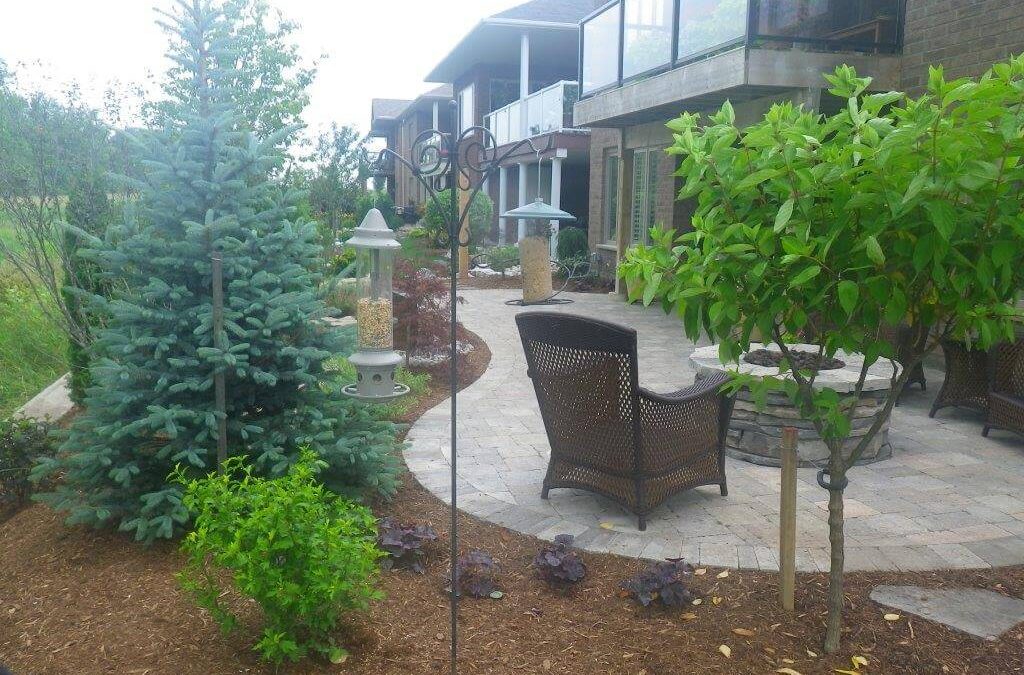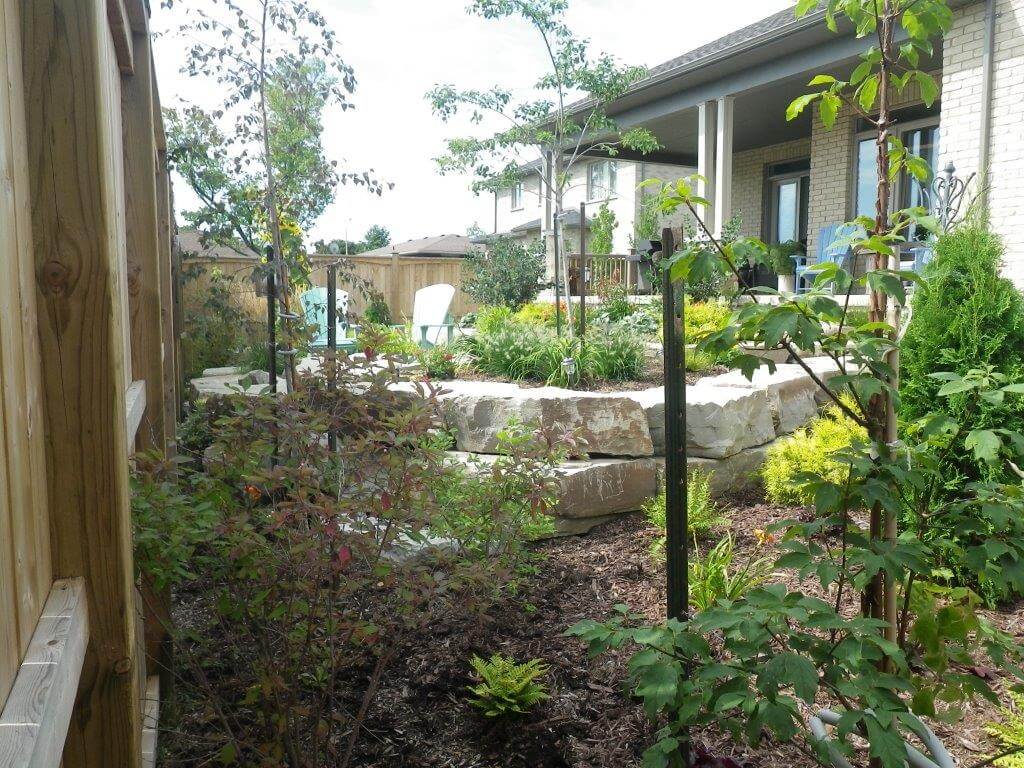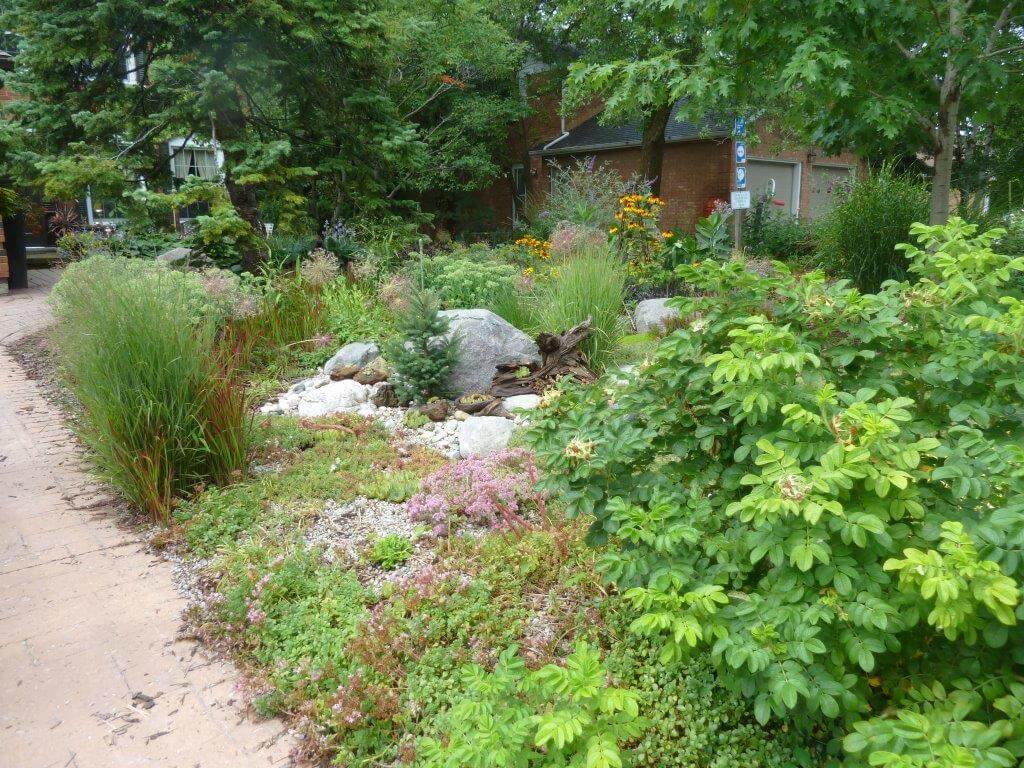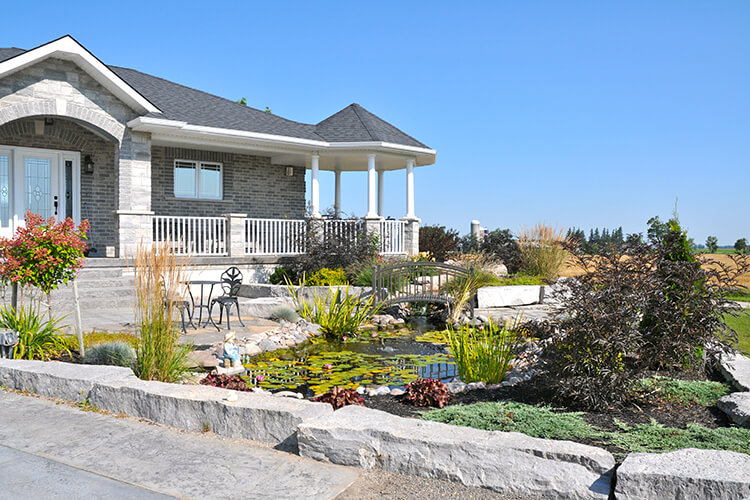
by A Touch of Dutch Landscaping | Jul 18, 2019 | Hardscaping, Landscape Design, Lawn care, Maintenance, Native Plants, Walkways
What to expect with low-maintenance landscaping
When we’re consulting with clients about their goals for new landscaping projects, by far the most requested characteristic is “low-maintenance”. But keep in mind that “low-maintenance” doesn’t mean “no maintenance”, so there’s still some work involved in keeping your lawn and garden looking great all season long.
If you’re looking to minimize the amount of work your lawn and flowerbeds need, we’ve got some tips that will allow you to spend more time enjoying your outdoor living spaces and less time maintaining them.
The Low-Maintenance Lawn
It may surprise you to learn that your lawn generally requires a lot more time to maintain that gardens do. Weeding, feeding, seeding, sodding, cutting, trimming, and watering all repeatedly require time, effort, and resources.
As such, the first thing we recommend doing is considering how much lawn you need for your lifestyle. While grass-covered turf does offer certain environmental benefits like absorbing toxins and carbon dioxide, other landscaping options can be just as beneficial. Chances are you can drastically reduce the amount of grass in your yard and replace those areas with other, much lower-maintenance elements.
One sure-fire way to reduce high-maintenance grass is to add some hardscaping to your yard. In addition to your driveway, porch, and deck, you might consider expanding your living space with a stone patio, fire pit area, and/or walkways. Adding crushed stone and pavers to high-traffic areas can significantly reduce maintenance while improving draining and weed control.

Trees
Large trees may require some maintenance in the form of trimming and/or raking leaves, but they offer many aesthetic and environmental benefits.
If you plan to add trees, give them a wide skirt of exposed earth (out to the drip line) and mulch well. This not only looks good, but furthers the reduction of grass that would otherwise need to be maintained.
Plant Selection
We’re fortunate to have myriad options when it comes to plants, flowers, and shrubs. However, if your goal is low-maintenance landscaping, you’ll want to be selective.
First and foremost, you can ensure the lowest maintenance gardens by choosing plants that are native to your region. These plants thrive in your region’s climate and soils, and historically have grown in the wild with no one but Mother Nature maintaining them. So you can bet they’ll thrive in your garden without too much attention.
Favour perennials over annuals. While the latter tend to be showier, they require more maintenance (deadheading and watering) and need to be replaced every year, adding both time and expense to your gardening requirements. To add pops of colour to your porch and patio but keep maintenance manageable, plant annuals in large containers.

It’s important to consider sun exposure when selecting plants – both annuals and perennials – for gardens and planters. Shade-loving plants will become scorched in anything other than morning sunlight. Sun-lovers planted in the shade will not reach their full potential and will get “leggy” reaching for the sun.
While it’s visually appealing to choose a variety of shapes, sizes, and textures, be sure to select plants for your garden that have similar needs. This will help you avoid having to care for plants individually, permitting you instead to apply what maintenance is required to all plants in your garden.
Beautiful plants come from healthy soil. Soils that are rich in nutrients with good drainage and low competition from weeds will foster healthy plants without much assistance.
Good quality compost adds a wide range of nutrients and healthy bacteria to soil, and can also ensure appropriate drainage. Peat moss can also improve drainage but has an acidic pH. Raised beds also drain better than those dug down into the ground. Finally, a thick layer of mulch will help reduce watering requirements and minimize weed growth. Topped up every spring, mulch also feeds the soil and adds a polished look to flower beds and gardens.
Here in Southwestern Ontario, our outdoor living season is short, so maximize enjoyment by minimizing your work. Consider where you spend the bulk of your time and effort outside and determine ways to reduce or eliminate it so you can spend more time basking in our summer weather, while it lasts.

by A Touch of Dutch Landscaping | Jun 23, 2019 | Fencing, Hardscaping, Landscape Design, Ponds, Retaining Walls, Walkways, Water Features
Enhance the comfort and beauty of your yard with hardscaping
Hardscaping is probably not a term you use very often, but it’s actually a common facet of landscaping. In fact, you probably have some hardscaping elements in your yard.
The “hard” in hardscaping refers to the non-living or inanimate elements in a yard’s layout. In contrast, “softscaping” includes all living matter including plants and flowers, trees and shrubs, plus soil, mulch, and of course grass.
Natural stone, wood, gravel, concrete (precast and pour-in-place), interlocking brick, and composite are the most common hard materials used in the creation of fencing, retaining walls, waterfalls, ponds, patios, pathways, and more.
Standard inclusions in virtually any property are walkways, a driveway, decking, and fencing. However, many home owners opt to upgrade at some point, either to add new features to their existing landscape or simply to update outdated elements.
So how do you decide what features to add or change and which materials to use? When we consult with our clients, we consider several variables including specific goals, personal style, the style of the home and surroundings, and budget.
One of the primary goals that hardscaping can help address is added privacy. You can achieve this by adding a fence line or panels, a wall(s) or even just creating a privacy screen on one or both sides of your deck or patio. To soften the overall appearance, consider combining hardscaping elements with tall shrubs or ornamental grasses that can also enhance privacy.
Another common goal is expanding outdoor living space. Options here are dependent on available space and budget, and can range from a small deck to a multi-tiered patio with an entertainment area, bar, built-in kitchen, pool, pond, waterfall, and/or fire table with seating.
Natural stone retaining walls are a great solution for adding depth and visual interest, or dealing with a steeply graded yard or uneven grading around the perimeter. Armour stone is a popular choice for creating retaining walls as they are large, but natural and create visual impact.
Pathways to and around your home can add visual appeal and can also create visual separation and definition of gardens. Although poured concrete is the standard for walkways between the driveway and front entrance, explore other options like flagstone, interlocking brick, decorative pavers, or even materials generally relegated to the backyard like wood or composite.
If there are areas around your home where grass doesn’t thrive due to inadequate drainage or poor sun exposure, adding gravel and stepping stones can improve the appearance while also making navigation around those areas easier.
A couple caveats before you get started
- Even if you plan to add hardscaping in phases – say, the patio first, and then a pond and retaining walls over the next couple years – it’s best to create the whole plan at the outset so that you can be sure everything will work together when the entire project is completed. Short-term oversights can lead to long-term headaches.
- Think about drainage and environmental issues when adding immovable objects like a patio or a wall. Consider incorporating a means of collecting runoff water for use around your yard.
- Balance is best. You can create contrast with various sizes and shapes. Use two to three different complementary materials in your project. And most importantly, don’t overdo it with hard elements in your yard. Mix hardscaping with softscaping for best results.
- Ensure your design is appropriate for your lifestyle. If you have young children, maintaining an open, grassy area is probably a good idea. If you’re older and want a low-maintenance yard, you might opt for more hardscaping and drought-tolerant plants.
- Choose the right materials for your style. Whether your taste is modern, traditional, or somewhere in between, some materials are going to suit your style better than others, so choose carefully.
Hardscaping can add so much beauty to your yard and enjoyment to your outdoor living space. Just be sure to plan ahead for best results. Of course, sometimes it’s all just too daunting. A Touch of Dutch Landscaping and Garden Services can consult with you to create and implement a plan and design that meets your needs and fits your budget. Contact us to get started.





